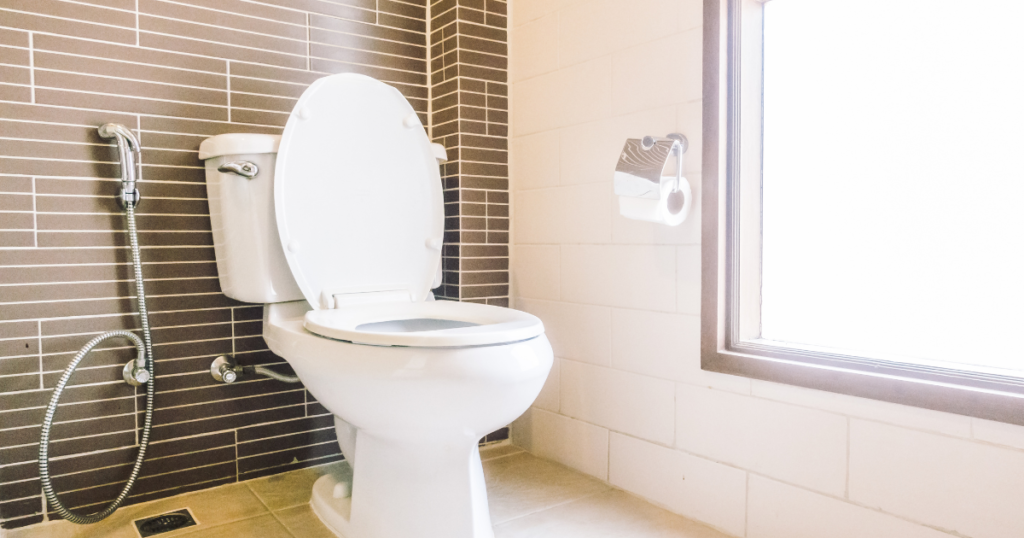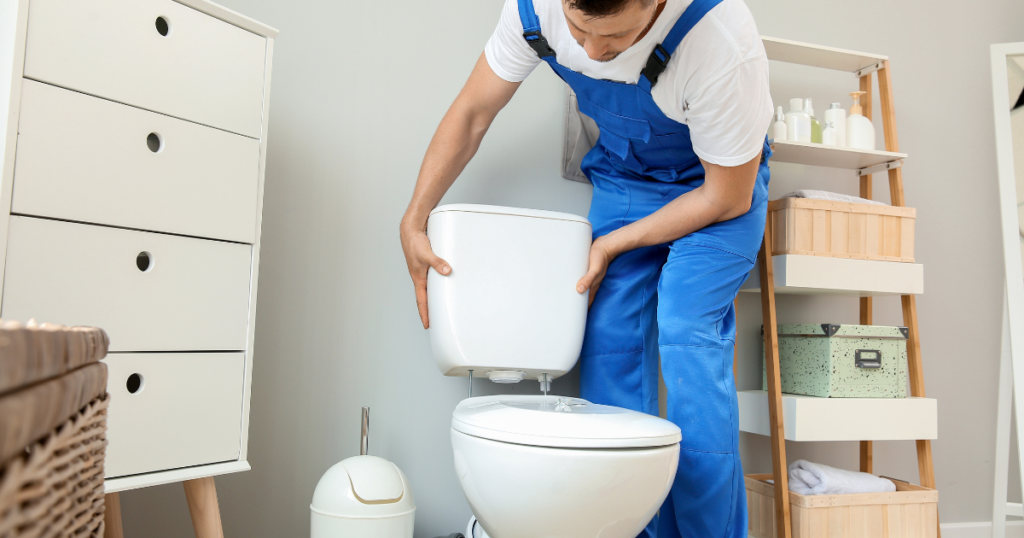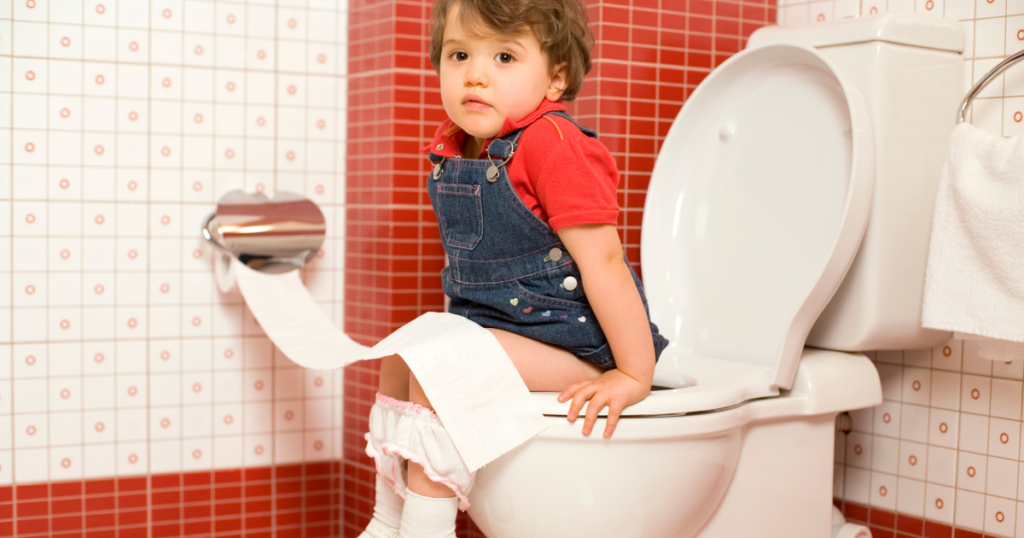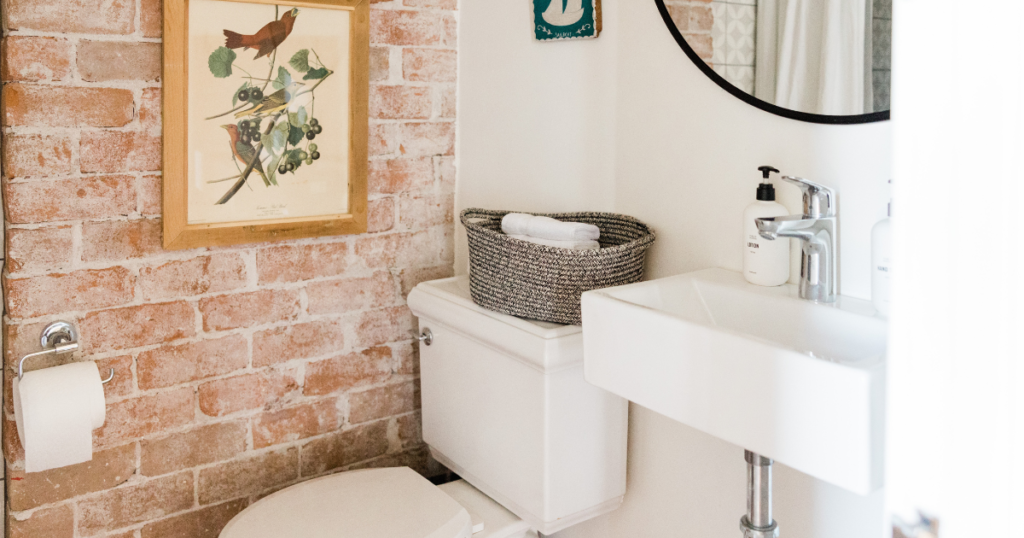
When it comes to selecting the perfect toilet for your bathroom, the classic two-piece design remains a popular choice for many homeowners.
Offering versatility, ease of installation, and a wide range of styles, two-piece toilets are both practical and reliable.
In this guide, we’ll walk you through the essentials of two-piece toilets 101, breaking down the key features, benefits, and what to look for when making your decision.
Whether renovating your bathroom or upgrading your existing fixtures, this guide will help you choose the right two-piece toilet to suit your needs and style.

Understanding Two-Piece Toilets 101
Two-piece toilets are standard in many households. They consist of a separate tank and bowl, providing flexibility and ease of replacement.
Benefits and Drawbacks
Benefits:
- Cost-Effective: Two-piece toilets are generally more affordable. They range from $250 to $700, including installation.
- Customization: You can easily mix and match tanks and bowls to suit different styles. This makes it easier to find a design that fits your bathroom decor.
- Repair: If one part breaks, replacing just the tank or bowl is simpler and less expensive than replacing the entire unit.
Drawbacks:
- Installation: Setting up a two-piece toilet can be more challenging. Aligning the tank and bowl can be tricky and might require professional help.
- Cleaning: The gap between the tank and bowl can collect dirt and bacteria, making cleaning more difficult.
- Size: These toilets often take up more space, which could be a concern in smaller bathrooms.
Components Explained
Tank:
- The tank holds water used for flushing.
- It is typically mounted on top of the bowl.
- Tanks come in different sizes and designs.
Bowl:
- The bowl is the part where waste is deposited.
- It connects directly to the plumbing system.
- Bowls can vary in shape and size, including round and elongated designs.
Flushing Mechanism:
- Located inside the tank.
- It includes parts like the flush valve, flapper, and fill valve.
- Efficient flushing systems can save water and reduce utility bills.
Seat:
- The seat is attached to the bowl.
- It can be easily replaced or upgraded.
- Seats come in various materials, such as plastic or wood, and may include features like soft-close lids.

Essential Measurements and Dimensions
Understanding the key measurements is crucial when choosing a two-piece toilet. These measurements impact the toilet’s fit, comfort, and functionality in your bathroom.
Toilet Rough-In
The toilet rough-in is the distance from the wall behind the toilet to the center of the drainpipe. In most homes, this measurement is typically 12 inches. However, some toilets require a rough-in distance of 10 or 14 inches.
Knowing your toilet’s rough-in size ensures a proper fit. Measure from the finished wall, not the baseboard or any trim.
Having the correct rough-in helps avoid costly plumbing adjustments.
Toilet Height
Toilet height is measured from the floor to the top of the bowl, excluding the seat. Standard-height toilets are 14 to 15 inches.
There are also “comfort height” toilets, which are 17 to 19 inches tall. These taller toilets are easier for people with mobility issues or disabilities to use.
Choosing the right height is essential for comfort and accessibility.
Toilet Flange and Finished Wall
The toilet flange is the pipe fitting that connects the toilet to the home’s drainage system. The flange must be level with the finished floor for a proper seal.
The distance from the flange center to the finished wall is critical; this should align with your rough-in measurement.
Correct installation avoids leaks and ensures the toilet stays securely in place.

Installation Process
Installing a two-piece toilet 101 involves several steps, from preparing your work area to tightening the last bolt. Having the right tools and knowledge can save you time and trouble.
Preparation and Tools
Before starting, I gather all the necessary tools. These include:
- Adjustable wrench
- Screwdriver
- Level
- Wax ring
- Supply line
Laying out all tools makes the process smoother.
Next, I check the water supply, ensuring the shut-off valve is operational.
I also make sure the flange, which connects the toilet to the waste pipe, is in good condition. A damaged flange can cause leaks and instability.
Finally, I position old towels or rags around the area to catch any water spills.
Planning ahead reduces stress and prevents mistakes.
Step-by-Step Guide
- Turn off the Water Supply: I close the shut-off valve and flush the old toilet to drain the water.
- Remove Old Toilet: Using a wrench, I unscrew the bolts and lift off the old toilet. Discard the old wax ring.
- Prepare the Flange: I clean and inspect the flange, ensuring it’s free from debris and damage.
- Install Wax Ring: I press a new wax ring onto the flange to ensure a good seal.
- Position the Bowl: Carefully, I lower the toilet bowl onto the wax ring, aligning the bolts with the holes. Press down to secure the seal.
- Secure the Bowl: Using nuts and washers, I tighten the bolts evenly, not too tight to avoid cracking the porcelain.
- Attach the Tank: I place the tank on the bowl, insert bolts through the holes, and tighten the nuts evenly.
- Connect Water Supply: I attach the supply line and open the shut-off valve to let water fill the tank.
Checking for leaks and making minor adjustments ensures everything functions well.
Common Mistakes to Avoid
One mistake I often see is overtightening the bolts. This can crack the porcelain, ruining the toilet.
Another common error is not aligning the wax ring properly, causing leaks.
I always double-check the alignment before pressing down the bowl.
Skipping the flange inspection is another frequent mistake. A damaged flange can lead to instability and leaks.
Finally, failing to secure the tank tightly can cause wobbling. I ensure all bolts are evenly tightened to keep the tank stable.

Flush Systems and Water Efficiency
Choosing the right two-piece toilet means paying attention to its flush system and water efficiency. I will explain how Gallons Per Flush (GPF) works, comparing single and dual flush systems and the role of the flush valve in achieving efficiency.
Understanding GPF
Gallons Per Flush (GPF) measures how much water a toilet uses each time it flushes. Modern toilets usually use about 1.6 GPF, but some can go as low as 1.28 GPF without sacrificing performance. Toilets that meet these criteria can help conserve water and reduce water bills. The WaterSense label marks toilets that use 20% less water than the federal standard of 1.6 GPF, making them ideal for water efficiency.
Comparing Single and Dual Flush
Single-flush toilets use the same amount of water for every flush, regardless of whether it’s liquid or solid waste. This simplicity can make them reliable and easy to maintain. On the other hand, dual-flush toilets offer two flush options: a low-volume flush for liquids and a higher-volume flush for solids. This allows users to control water usage more precisely. Even though dual flush toilets may cost more initially, the water savings over time can offset this expense.
The Role of the Flush Valve
The flush valve is a crucial component affecting how efficiently a toilet uses water. It controls the release of water from the tank into the bowl. Larger flush valves can improve flushing power while still using less water. Pressure-assisted flush valves can be more forceful, requiring less water to clear the bowl. This makes them effective in maintaining hygiene while being water-efficient.

Additional Considerations
When selecting a toilet, there are other factors beyond the basic model and style. Whether it’s comparing one-piece and two-piece options, adding a bidet, or working around your bathroom’s ventilation, these considerations can impact your final decision.
Choosing Between One-Piece and Two-Piece Toilets
Size and Installation:
A one-piece toilet combines the tank and bowl into a single unit, making it more compact. This can be ideal for smaller bathrooms. On the other hand, two-piece toilets have a separate tank and bowl, which can make them easier to transport and install, but they might take more space.
Cleaning and Maintenance:
One-piece toilets are simpler to clean because they have fewer crevices where dirt and bacteria can accumulate. Two-piece models have a seam between the tank and bowl, which can harbor grime and require extra attention during cleaning.
Customization and Replacement:
Two-piece toilets offer more flexibility for customization. If the tank or bowl becomes damaged, you can replace one part instead of the entire unit. This can be more cost-effective.
Integrating a Bidet
Space and Layout:
Adding a bidet can improve hygiene but requires enough space in your bathroom layout. Typically, a standalone bidet needs additional floor space. Alternatively, a bidet seat can be added to many standard toilets, saving room.
Plumbing Needs:
Installing a bidet may entail extra plumbing work. A standalone bidet requires separate plumbing lines, while bidet seats usually need only a water supply and an electrical outlet. Ensure your bathroom’s plumbing can accommodate these changes.
Cost Considerations:
Standalone bidets and integrated bidet seats vary in price. Bidet seats tend to be less expensive and simpler to install. However, they might not offer all the features of a standalone model. Consider what fits best within your budget and meets your needs.
Adapting to Bathroom Vents
Ventilation Requirements:
Proper ventilation is crucial to avoid moisture buildup, which can cause mold and mildew. If replacing an old toilet or adding a bidet, check that your current bathroom venting system can handle any additional moisture.
Types of Vents:
Bathrooms typically use exhaust fans to remove humidity. If your existing system is inadequate, you might need to upgrade the fan or add vents to improve airflow. This ensures the space stays dry and mold-free.
Installation Challenges:
Adding or upgrading vents can be a complex task that might require professional assistance. Depending on your bathroom’s layout, this could involve cutting through walls or ceilings. Make sure to account for these potential hurdles ahead of time.
Wrapping Up
Choosing the right two-piece toilet for your bathroom doesn’t have to be daunting. By understanding the key features, benefits, and available options, you can confidently select a toilet that meets your functional needs and aesthetic preferences.
Whether you prioritize ease of installation, maintenance, or style, the right two-piece toilet can enhance your bathroom’s comfort and efficiency.
Remember, this essential fixture is more than just a necessity—it’s an integral part of your daily routine, so investing in the right one is well worth it.
Frequently Asked Questions
When choosing between a one-piece and a two-piece toilet, it’s crucial to understand what sets them apart. Each type has its own benefits and drawbacks.
What are the main differences between one-piece and two-piece toilets?
One-piece toilets have a seamless design, making them easier to clean. They are often more durable and less prone to leaks. However, these toilets tend to be more expensive and heavier, which might make installation more challenging.
Two-piece toilets consist of a separate tank and bowl. They are usually less expensive and easier to transport. This type can be more prone to leaks at the joint between the tank and the bowl but offers more flexibility in repairs and replacements.
